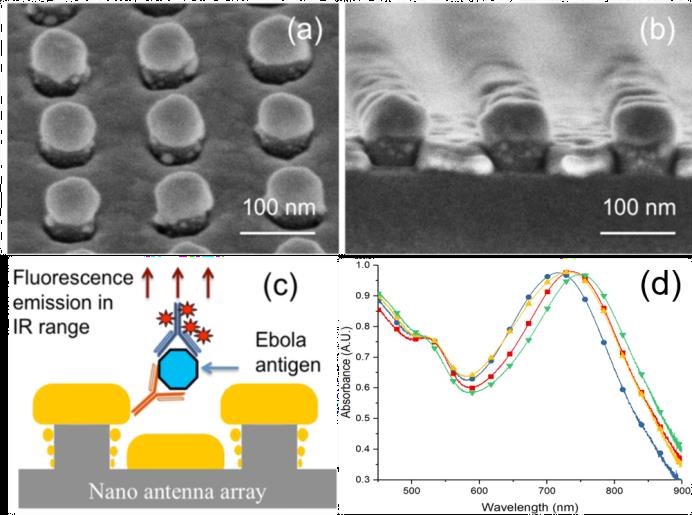Nanoantenna-enabled ultrasensitive virus antigen biosensors
Date: 2021/10/28 - 2021/10/28
Academic Seminar: Nanoantenna-enabled ultrasensitive virus antigen biosensors
Speaker: Dr. Zhijuan Su, Postdoctoral Researcher in the Department of Electrical and computer Engineering at Princeton University
Time: 9:00a.m.-10:00a.m. Oct 28th, 2021 (Beijing Time)
Location: Room 454, Longbin Building
Abstract
Scalable nanofabrication combining nanoimprint lithography and thin-film processes has been utilized for creating three-dimensional nanoantenna sensors for ultrasensitive Ebola antigen detection. Sensitive detection of pathogens is crucial for early disease diagnosis and quarantine, which is of tremendous need in controlling severe and fatal illness epidemics such as of Ebola virus (EBOV) disease. Serology assays can detect EBOV-specific antigens and antibodies cost-effectively without sophisticated equipment; however, they are less sensitive than reverse transcriptase polymerase chain reaction (RT- PCR) tests. We have developed a plasmonic nanoantenna-array-based biosensor platform for the detection of Ebola virus (EBOV) antigen – soluble glycoprotein (sGP) – that is over 10,000-fold more sensitive than conventional enzyme-linked immunosorbent assays (ELISA). The sensor maximizes the excitation laser absorption efficiency on-chip to 95%, and has demonstrated an analytical sensitivity of 95.8%. These results combined highlight the significant potential of the nanostructured biosensor in ultrasensitive detection of pathogens.

Figure 1. Nanoimprinted transducer for sensitivity-enhanced bio-detection. (a) and (b) SEM images of nanoantenna array, (c) Ebola antigen biosensing on the nanoantenna. (d) Absorption spectra.
The biosensor was nanofabricated through nanoimprint lithography and thin film process (Figure 1a and 1b). The nano-gap between the gold top disk and bottom plane creates localized high electromagnetic field, tremendously enhancing the efficiency of light absorbance at 785nm wavelength (Figure 1d). With a sandwich assay protocol (Figure 1c), the sensor responded to different dilutions of sGP in human plasma samples, which reached a limit of detection (LoD) of 1:12,000 dilution compared to a 1:128 dilution in the conventional ELISA. The analytical sensitivity of EBOV sGP spiked in human plasma at 2X LoD reached 95.8%.
In summary, we developed an ultra-sensitive Ebola virus antigen test based on nanostructured plasmonic resonance biosensor. This work provides a proof-of-concept for the development of ultra- sensitive tests to diagnose EBOV infection in human plasma samples. The sensing and scalable manufacturing technologies developed in this research will contribute to a universal next-generation biosensing platform for early detection of a wide-range of pathogens.
Biography
[caption id="attachment_127816" align="alignleft" width="150"] rptoz[/caption]
rptoz[/caption]
Zhijuan Su has been working as a Postdoctoral Researcher with Prof. Stephen Y. Chou in the Department of Electrical and computer Engineering at Princeton University from 2017 to 2021. She received her Ph.D. in Electrical and Computer Engineering from Northeastern University, Boston in 2016. She received the B.S. degree from Nanjing University and M.S. degree from Shanghai Jiao Tong University, respectively. Her research interests include nanofabrication, nanophotonics, nano- bioengineering, with a focus on ultrasensitive biosensing via 3D nanostructures. Her work has been published in top tier peer-reviewed journals, including Advanced Materials, ACS nano, Applied Physics Letters, etc.
